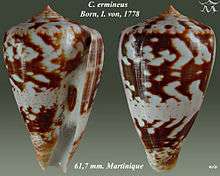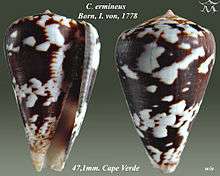Conus ermineus
| Conus ermineus | |
|---|---|
 | |
| Apertural and abapertural views of shell of Conus ermineus Born, I. von, 1778 | |
| Scientific classification | |
| Kingdom: | Animalia |
| Phylum: | Mollusca |
| Class: | Gastropoda |
| Clade: | Caenogastropoda |
| Clade: | Hypsogastropoda |
| Clade: | Neogastropoda |
| Superfamily: | Conoidea |
| Family: | Conidae |
| Genus: | Conus |
| Species: | C. ermineus |
| Binomial name | |
| Conus ermineus Born, 1778 | |
| Synonyms[1] | |
| |
Conus ermineus, common name the turtle cone, is a species of sea snail, a marine gastropod mollusk in the family Conidae, the cone snails and their allies.[1]
Like all species within the genus Conus, these snails are predatory and venomous. They are capable of "stinging" humans, therefore live ones should be handled carefully or not at all.

Distribution
This species occurs in the Caribbean Sea and the Gulf of Mexico; in the Atlantic Ocean off West Africa and the Cape Verdes; in the Indian Ocean off Tanzania.
Description
The maximum recorded shell length is 103 mm.[2]
Conantokin-E is a toxin derived from the venom of Conus ermineus.
It is a fishing eating species. Utilizes specialized hollow harpoon like radula tooth to harpoon small fish and paralyze them with venom to facilitate swallowing.
Habitat
Minimum recorded depth is 0 m.[2] Maximum recorded depth is 101 m.[2]
References
- 1 2 Conus ermineus Born, 1778. Retrieved through: World Register of Marine Species on 27 March 2010.
- 1 2 3 Welch J. J. (2010). "The "Island Rule" and Deep-Sea Gastropods: Re-Examining the Evidence". PLoS ONE 5(1): e8776. doi:10.1371/journal.pone.0008776.
- Petit, R. E. (2009). George Brettingham Sowerby, I, II & III: their conchological publications and molluscan taxa. Zootaxa. 2189: 1–218
- Puillandre N., Duda T.F., Meyer C., Olivera B.M. & Bouchet P. (2015). One, four or 100 genera? A new classification of the cone snails. Journal of Molluscan Studies. 81: 1-23
Gallery
 Conus ermineus Born, I. von, 1778
Conus ermineus Born, I. von, 1778 Conus ermineus Born, I. von, 1778
Conus ermineus Born, I. von, 1778 Conus ermineus Born, I. von, 1778
Conus ermineus Born, I. von, 1778
External links
| Wikimedia Commons has media related to Conus ermineus. |